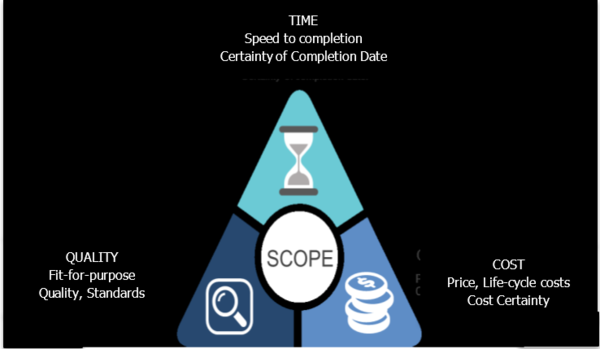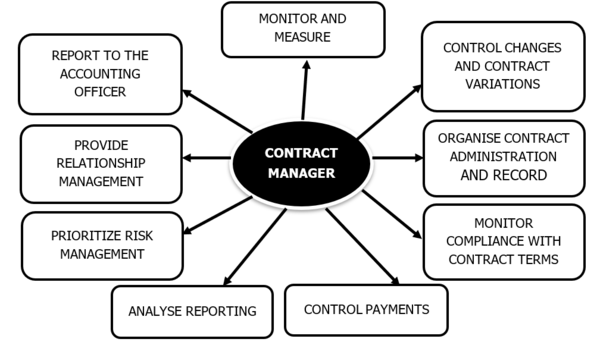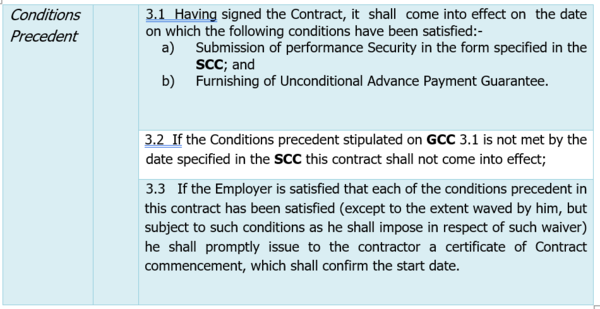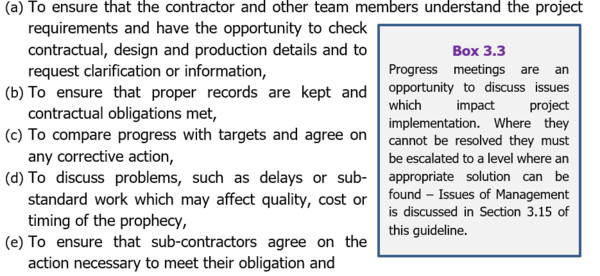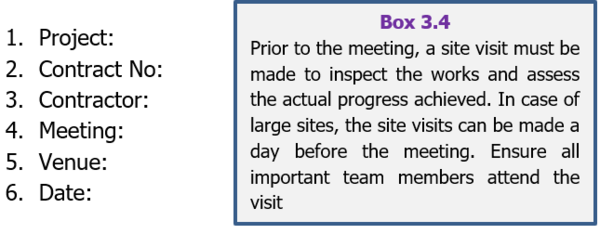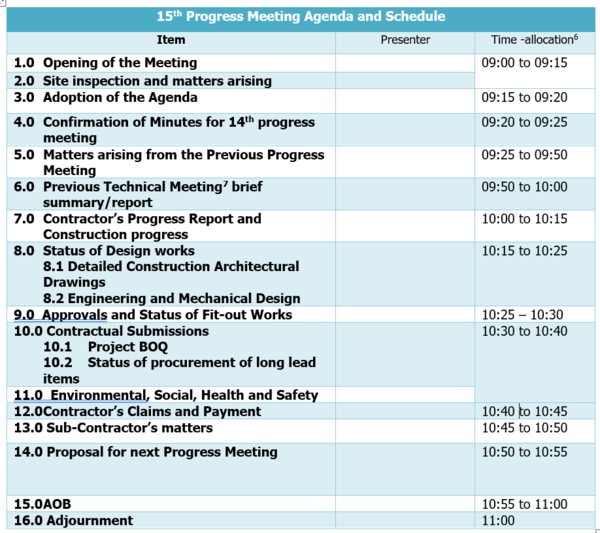Difference between revisions of "Chapter Three: contract management"
| Line 233: | Line 233: | ||
The other most important meetings on a project are the regular project meetings, sometimes termed site meetings or progress meetings. They are normally held at monthly intervals and they provide the opportunity for a regular, comprehensive re-appraisal of the project. These meetings are usually chaired by the PM. They permit a full and frank discussion of the contract, the giving of early notice of disputes which may not be capable of resolution at site Level and the receipt of any legitimate complaints against the performance of the contractor. | The other most important meetings on a project are the regular project meetings, sometimes termed site meetings or progress meetings. They are normally held at monthly intervals and they provide the opportunity for a regular, comprehensive re-appraisal of the project. These meetings are usually chaired by the PM. They permit a full and frank discussion of the contract, the giving of early notice of disputes which may not be capable of resolution at site Level and the receipt of any legitimate complaints against the performance of the contractor. | ||
The main functions of project meetings are as follows: | The main functions of project meetings are as follows: | ||
| + | |||
[[File:Document_3.PNG|600px|link=Chapter_Three:_contract_management]]<br> | [[File:Document_3.PNG|600px|link=Chapter_Three:_contract_management]]<br> | ||
(f) To check that variations are confirmed in writing and that work is recorded and agreed.<br> | (f) To check that variations are confirmed in writing and that work is recorded and agreed.<br> | ||
| Line 238: | Line 239: | ||
Agenda | Agenda | ||
A formal agenda should be prepared for each project meeting to provide a sound basis for discussion at the meeting. Table 3.2 Shows a Typical Agenda for a Monthly Progress Meeting. | A formal agenda should be prepared for each project meeting to provide a sound basis for discussion at the meeting. Table 3.2 Shows a Typical Agenda for a Monthly Progress Meeting. | ||
| − | + | ||
| + | [[File:Document_4.PNG|600px|link=Chapter_Three:_contract_management]]<br> | ||
| + | [[File:Document_5.PNG|600px|center|link=Chapter_Three:_contract_management]]<br> | ||
| + | ====Conduct of Meetings==== | ||
| + | The chairman of the meeting, in consultation with the secretary, should ensure that dates for meetings are fixed, venues reserved and all participants are notified. The chairman will approve the agenda and usually give members the opportunity to suggest additional items for inclusion. He will also ensure that they arrive adequately prepared. A chairman should desirably be impartial, reasonable and responsive. Formal minutes or notes will be taken of the main points discussed and decision made. | ||
| + | |||
| + | The chairman should plan the discussion around the agenda to enable members to make a positive contribution and to ensure the smooth and rapid progress of the meeting. The main objective should be to reach unanimous decision in a minimum time. An efficient chairman will at the outset of a meeting determine the purpose of the meetings its direction, the limits of discussion and the timescale. | ||
| + | The Box 3.5 gives some tips on how to hold and manage project progress meetings. The same tips are applicable to any important meetings. | ||
| + | |||
</div> | </div> | ||
Revision as of 15:44, 15 July 2022
Contents
- 1 Chapter Three: contract management
1 Chapter Three: contract management
1.1 Importance of Contract Management
Contract management involves activities performed by a PE after a contract has been awarded to determine how well the PE and the contractor performed to meet the requirements of the contract. It encompasses all dealings between the PE and the contractor from the time the contract is awarded until the work has been completed and accepted or the contract terminated, payment has been made, and disputes have been resolved. As such, contract management constitutes that primary part of the procurement process that assures the PE gets what it paid for. The basis of Contract management is the contract signed between the Client and the Contractor.
As a rule PEs are required to use PPRA Conditions of Contract drawn from Standard Tender Documents for Small Works, Standard Documents for Medium and Large Works. In situations where PPRA documents are not suitable, the contract document could be drawn from various sources such FIDIC, World Bank, European Union subject to approval of PPRA. For donor funded projects and where there is stipulation to use procurement rules of the funding agency, the documents approved by the funding agency shall be used and such approval from PPRA shall not apply. There are three aspects to a contract that must be managed while the assignment is being carried out: time, cost and quality as shown in Figure 3.1.
Time and cost must be measured against the budget and projected time required to complete the contract to detect deviations from the plan. The performance of the contract must be checked to ensure that the targets are being met.
Good contract administration assures that the end users are satisfied with the product or service being obtained under the contract. It is absolutely essential that those entrusted with the duty to ensure that the PE gets all that it has bargained for must be competent in the practices of contract management and are aware of and faithful to the contents and limits of the delegation of authority from their Employers.
Figure 3.1 Time, Cost, Quality (TCQ) Interdependencies5
There are many post-contract issues that need to be dealt with, monitored and resolved before the contract reaches its conclusion and these include the following:
- Appointment of a PM and Supervising Engineer;
- Contract Effectiveness;
- Contract Delivery Follow-up;
- Progress Monitoring and Control;
- Preparation of Interim and Final Certificates and managing payments to the Contractor;
- Delays in Performance;
- Initial and Final Acceptance of the works;
- Contract Close Out
- Stakeholder’s Management;
- Communication Management;
- Issues Management;
- Relationship Management;
- Claims Management;
- Disputes Management;
- Managing Termination of Contract;
- Evaluating of Contractors Performance.
1.2 Appointment and Roles of Project Manager
1.2.1 Appointing a Project Manager (Supervisor)
Regulation 243 of the PPR 2013 emphasizes the need for each contract, a PE to monitor the performance of a contractor entrusted to implement a contract. It is usually advisable to appoint a person within the organisation to oversee the management of a contract.
Similarly Regulation 252 of PPR 2013 provides for Appointment of Works Supervisor – normally a public officer, a unit responsible for works in PE or a Consultant- Manages the work of the inspection committee. Also Condition of Contract including those contained in PPRA’s Standard Tender Documents for Works makes it mandatory to appoint a PM. According to the documents:
The PM is the person named in the Special Conditions of Contract (SCC) (or any other competent person appointed by the Employer and notified to the Contractor, to act in replacement of the PM) who is responsible for supervising the execution of the Works and administering the Contract.
Contract management for works is often complex and time-consuming, as it involves supervision of the progress of the works, ordering variations where unforeseen conditions are encountered and measuring the works completed for payment purposes. For major contracts, a PE will normally use a full-time supervising engineer or PM, who will exercise control and supervision of the contract on its behalf. Where a PM is used, the PE must:
1.2.2 Responsibilities of the PM
As discussed above once a PM is appointed, the PE must ensure that his roles are clearly defined. The following are some of the responsibilities of the PM:
(a) Monitoring the performance of the contractor, to ensure that all delivery or performance obligations are met or appropriate action taken by the PE in the event of obligations not being met;
(b) Ensuring that the contractor submits all required documentation as specified in the tendering documents, the contract and as required by law;
(c) Ensuring that the PE meets all its payment and other obligations in time and in accordance with the contract.
(d) Ensuring that there is adequate cost, quality and time control, as required;
(e) Preparing any required contract variations or change orders and obtaining all required approvals before their issue. Such variations or change orders must be clearly justified in writing backed by supporting evidence;
(f) Managing any handover or acceptance procedures;
(g) Making recommendations for contract termination, where appropriate, obtaining all required approvals and managing the termination process;
(h) Ensuring that the contract is complete, prior to closing the contract file including all handover procedures, transfers of title if need be and that the final retention payment has been made;
(i) Ensuring that all contract administration records are complete, up to date, filed and archived as required,
(j) Ensuring that the contractor and the PE act in accordance with the Provisions of the Contract, and
(k) Discharging of performance guarantee where required.
1.2.3 Requisite Skills Set of Project/Contract Manager
Good practice requires that a PM is appointed for every contract. For small, routine contracts, this may be one person, who has a portfolio of contracts to manage. For large, complex, high-value contracts this is normally an entity (Engineer, PM Etc.) The PM needs to have the appropriate range of qualifications, skills mix and experience. A project will have a good head start if it has a qualified and experienced PM. The PM, both acting on behalf of, and representing the Ministry, has the duty of ‘providing a cost-effective and independent service, selecting, correlating, integrating and managing different disciplines and expertise, to satisfy the objectives and provisions of the project brief from inception to completion. The service provided must be to the Ministry’s satisfaction, safeguarding its interests at all times. The key role of the PM is to motivate, manage, coordinate and maintain the morale of the whole project team. This leadership function is essentially about managing people and its importance cannot be overstated. A PM needs to multi-task, as for example, shown in Figure 3.2.
Hard skills - technical skills
Typical technical skills, knowledge and experience required include:
(a) Procurement;
(b) Project management;
(c) legal knowledge (at the very least an ability to understand the legal aspects of the contract, including remedies);
(d) Financial management;
(e) Analytics and reporting;
(f) Administrative, record keeping.
Additional skills may be required because of the subject matter or complexity of the contract. It is essential to have access to sufficient skills and experience as and when required. For example: civil engineering, water engineering; environmental and/or social knowledge and skills; and safety expertise;
Soft skills – interpersonal skills
In addition to technical (“hard skills”), a range of “soft skills” are required to build a successful relationship with relevant stakeholders, and to build successful contract management teams. Examples of relevant soft skills include: leadership, motivation and team building; decision making; interpersonal, communication and relationship management; mentoring and knowledge transfer; negotiation and conflict resolution; time management; and goal orientated, outcome focused.
Some of the key skills that a PM may normally possess are listed in Table 3.1.
1.3 Contract Effectiveness
Although the contract may have been signed by both parties, the legal effectiveness of the contract may be dependent on one or more of the following conditions: (1) Receipt by the PE of the Performance Security; (2) Receipt by the PE of an Advance Payment Security; (3) Payment to the Contractor an Advance Payment; and/or (4) Mobilization and Site possession by the Contractor. PPRA’s General Conditions of Contract for works provides conditions for contract effectiveness, reproduced below, which must be observed by the PEs.
Therefore, a person responsible for Contract Management i.e. the PM needs to ensure that:
- Any Performance Security specified in the contract is received by the PE, failure of which means that there is no contract;
- Any Advance Payment specified in the contract is paid immediately when the Advance Payment Security is received from the Contractor;
- Both the Performance Security and Advance Payment Security submitted by the Contractor are verified with the issuer of the same, to avoid possibility of forgery. This should be done through official correspondences which shall be filed in the Contract File.
- Once issued with a certificate of Contract Performance, the Contractor meets the agreed dates for mobilization and possession of the site.
1.4 Contract Management Plan (CMP)
The Contract Management Plan is an input/output document that outlines the method in which a specific contract will be administered and executed. The CMP document will traditionally include a number of items such as requirements of documentation delivery and requirements of performance. A CMP can come in many forms. They can be formally written documents, in which nearly every detail is touched upon, or they can be written very informally, containing only top level information which can be filled in with more specificity at a later time. CMPs, as with most elements of the effective management of projects, should in fact be implemented as early in the life cycle of a project as possible.
In the event circumstances change, it may be possible to modify a CMP with the agreement of all parties. Make sure every contract management is tailored to the individual contract - the content and amount of detail will depend on the nature of the services, the clients and the contract. The plan should set out:
(a) who will be responsible for managing the delivery of the contract,
(b) the nature and extent of engagement with the supplier or provider,
(c) how issues and disputes will be resolved,
(d) potential risks, how they'll be mitigated and managed and by whom,
(e) a methodology and plan for evaluating the quality of delivery and the benefits achieved,
(f) key stakeholders (internal and external) and how these relationships will be managed,
(g) an exit strategy to be applied at the end of the contract.
The PM shall prepare a CMP which shall give a background of the contract and capture the key focus areas of the contract, and this may as well be a subject of discussion in the Project Kick-Off Meeting discussed in Section 3.3.2.2
It shall contain the following.
(a) Background Information.
(b) Contract management team.
(c) Contractor details.
(d) Scope of contract management.
(e) Key provisions of the contract.
(f) Duties and responsibilities.
(g) Communication channels.
(h) Review and reporting requirements.
(i) Activities and timescales.
(j) Any other information which will assist the contract management team in its task.
A Template for typical Contract Management Plan is attached as Appendix 1.
1.5 Contract Delivery Follow-up
1.5.1 Definition of Contract Delivery Follow-up
One important aspect of contract management is to follow up on the state of what has been bought after it has been delivered, to ensure that the PE is satisfied. The extent of the follow-up may vary, depending on the contract value. Responsible PE staff should establish any expected delivery follow-up requirements at the time the contract is being set up. In many cases, problems arise during implementation because mitigating measures were not taken into account during the preparation of the contract.
It is normally required to deal with reports of unsatisfactory performance immediately. Decision must be made on a contractor who is not executing works to the expected quality standards or who has delayed the works on whether it should be considered as a contract default and what steps should be taken.
Contract delivery follow-up is also responsible for dealing with a contractor whose works during the execution or during the defects liability period have become defective or fail to meet contract requirements as a result of faulty construction, materials or workmanship.
1.5.2 Contract File
In order to allow for effective contract delivery follow-up, the PM is required to open and keep a contract file after the contract is signed. The Contract File supersedes the Procurement File which is used for the purpose of keeping all important records of the procurement process until a formal contract is entered.
It is important to appreciate that proper record keeping is fundamental to contract administration. Therefore a contract file is used for recording all information regarding the actual performance of the requirements of the contract. The file should contain the following:
(a) Signed original procurement contract
(b) Any signed modifications to the contract
(c) Contract correspondence between the parties
(d) Information on performance
(e) Correspondence relating to the contract
(f) Management progress reports
(g) Minutes of meetings of project team
(h) Payment records and close up documents
(i) Copy of performance security (where required)
(j) Any other relevant information.
PPRA has prepared a guide of records to be maintained in the procurement and contract file as shown in Appendix 2.
1.5.3 Contract Delivery Follow up for Works
In works contract delivery follow-up encompasses the following:
(a) ensuring that the actual mobilisation and completion dates are agreed with the contractor, based on the date of contract
effectiveness;
(b) monitoring the overall progress of the works and the performance of the PM;
(c) reporting any contractual problems or requests for contract amendments to the PMU;
(d) checking and ensuring that invoices and supporting documentation for payment are correct and arranging payment;
(e) managing any securities, such as performance or payment securities, by ensuring that they are kept securely, ensuring that extensions to their validity are obtained in good time, when required, reducing their value when required, and releasing promptly, when all obligations have been fulfilled;
(f) ensuring all final acceptance and hand-over arrangements are completed and documented satisfactorily; and
(g) ensuring all final drawings, manuals etc. are received and kept in an appropriate place.
One of the serious problems in project implementation is the lack of a dedicated person at the Head Office who has the responsibility of following up and overseeing those decisions required at the Head Office relating to a particular project are made in time. This leads to a situation where a project’s progress is affected because of lack of timely decisions/approvals which are required to enable smooth execution on the part of the contractor. It is therefore important for a PE to appoint a dedicated person in its headquarters who shall be responsible to oversee the affairs of the project. This person is sometimes known as a Project Coordinator to distinguish him from the Project Manager.
1.6 Progress Monitoring & Control
1.6.1 Site Recording and Control Tools
1.6.1.1 Site Records
The keeping of continuous and comprehensive site records provides an effective means of controlling and monitoring all activities of a project on the site. Records have a vital role to play in the assessment and settlement of disputes. They can take a wide variety of different forms and the following list embraces most of the more common records kept by the contractor’s representative.
(a) All correspondence between a contractor and PM, including PM’s instructions, variation orders and approval forms,
(b) All correspondence between the Contractor and the Employer and third parties,
(c) The minutes or notes of formal meetings,
(d) Daily, weekly and monthly reports submitted by the Contractor’s staff,
(e) Plant and labourers’ returns,
(f) Work records such as dimension books, timesheets and delivery notes,
(g) Day work records,
(h) Interim statements as submitted including any corrections, with copies of all supporting particulars and interim certificates,
(i) Level and survey books, containing checks on setting out and completed work,
(j) Progress drawings and charts and revised drawings,
(k) Site diaries, laboratory reports and other test data,
(l) Weather records,
(m) Progress photographs and
(n) Administrative records, such as leave and sickness returns, and accident reports?
1.6.1.2 Site Correspondence
All letters, faxes, e-mails, drawings and other documents should be recorded as they are received or dispatched, and all incoming documents should be date stamped. Verbal instructions from the PM and telephone conversation where they convey instructions or important information should always be confirmed in writing. Copies of all correspondence, whether in the form of formal letters or handwritten notes, should be carefully retained, along with old diaries, notebooks, field books and similar data. The originals of every incoming letter and clear copy of every outgoing correspondence, with any enclosure, should be placed in a file containing a suitable reference title. Additional but rather time consuming and costly measures that are sometimes taken include the keeping of a register of all correspondences and making extra copies of each outgoing letter which is kept in a file.
1.6.1.3 Site Reports
A report is primarily a summary of information and the principal method of conveying information on site matters to the head office, the employer and other parties. Daily reports by Supervisors on site, form an important part of site communications. These reports contain details of the work carried out, weather conditions, the number of employees engaged on the work number and types of plant in use and hours worked, and details of any delays and their causes. Starts and completions of activities should be noted. After having been processed, the reports should be filed and stored neatly and chronologically for ease of reference. Technical reports may be prepared on laboratory tests and special reports on specific problem areas.
1.6.1.4 Labour and Plant Return
The contractor’s labour and plant returns constitute another commonly employed form of written record, the contractor will normally be required by the PM to submit at prescribed intervals, such as monthly, the number and categories of labour and plant engaged on the site. Apart from this requirement from the PM, such records assist the contractor to establish how efficiently he is utilizing his labour force, especially when such records are accompanied with the amount of work done on a daily basis for various categories of labour.
1.6.1.5 Laboratory Tests
Laboratory reports and other test results are normally entered on standard forms and files on a subject basis. Common tests include concrete cube strengths, earthworks density, compaction and moisture content, and analysis of bituminous products. On occasions, the information is more effectively presented diagrammatically as in the form of graphs for matters such as standard sieve analyses. Statistical analysis of data can encompass the determination of such parameters as range, standard deviation and coefficient of variation. The laboratory may also undertake the recording of rainfall, temperatures, wind speeds and tides.
1.6.1.6 Photographs
It is good practice to take photographs of the main features of the project from the same position at regular intervals, often monthly, to provide an excellent record of progress throughout the project. These photographs are often supplemented by photographs of particular features such as rejected section of honeycombed concrete, irregular brickwork, bank slippage and extent of flooding resulting from exceptionally heavy rainfall. The photographs should be taken with a good quality camera and they should have details of the date, subject, position and direction from which it was taken recorded.
1.6.1.7 Diaries
Diaries are indispensable as they provide a complete narrative of the progress of the works and the activities of the Contractors. The diary entries collectively supply comprehensive information on all aspects of the works and also permit cross checking to elucidate disputed statements. A diary provides a factual record of events on site, discussions with the PM’s staff and other personnel, instructions issued and weather conditions. All entries must be accompanied by details of the time, location and personnel involved.
1.6.2 Project Meetings
1.6.2.1 Purpose of Meetings
During the course of a contract, a variety of meetings will take place in site offices, on specific parts of the works and in the suppliers’ premises. Some may be called at short notice to resolve a problem on the site, while others will be formally arranged at regular intervals and are generally concerned with co-ordination and progress. The main objective of all meetings is to come to a decision, although supplementary aspects like generation of ideas and discussion of problems may also be important. Meetings can, however, fail to achieve these objectives through over-formality, ineffective chairmanship, failure to concentrate on key issues or an antagonistic attitude by one of the parties.
Information meetings are generally concerned with the removal of unacceptable work or materials or the continuance or discontinuance of a particular method of operation. A note in the participant’s diary may be sufficient to record the incident and the action taken. Where, however there is a dispute over facts or liability, then the PM may call a meeting with a Contractor’s representative by notifying him, of the proposed daytime and place of the meetings, the names of those invited and the substance of their discussion.
From time to time, it may be necessary to convene a formal meeting to discuss a specific matter which has become important to the progress of the project. Three important categories of meetings can be identified:
a) Discussion between senior members of the site organization, often involving the contractor’s representative and the PM
b) Meetings with the sub-contractor and suppliers, and
c) Meetings involving a third party, such as a statutory undertaker
1.6.2.2 Project Kick-off Meetings
Projects do not always go through an organized sequence of planning, approval and execution. Sometimes one can be executing a project and finds that team members and stakeholders have varying levels of understanding about the purpose and status of the project. Just as a project should have a formal end-of-project meeting to signify that it is complete, it also makes sense to hold a formal kickoff meeting to start a project.
Items of agenda for the Meeting
Regardless of who is in attendance at the kickoff meeting, there are a host of topics that should be covered or at the very least be touched on. These can be grouped into: project plans, ongoing concerns, and closeout.
The Project Plans
This includes the actual drawings and specs for the project. But it is also important to discuss things like the schedule, what permits need to be pulled, proposed start and finish dates for specific trades, and it is important to identify key milestones for the life of the project. Finally, when everyone leaves a kickoff meeting, they should have a concrete understanding of where their scope of work begins and ends.
Ongoing Concerns
It is a good idea to agree on meetings to be set- weekly or monthly meeting schedules during the kickoff meetings. Other topics to be covered should include: payment schedules, processes for implementation of change orders, the submittal and approvals process, and how much retainage will be withheld from progress payments. How and when material deliveries should take place might also be discussed. Not to be overlooked is safety – safety protocols and procedures should be discussed from the get-go, and it is probably a topic that should come up often at weekly meetings, too.
Closeout
It may seem a little early, but it is a good idea to discuss closeout procedures as early as possible. Information like when retainage will be released, punch list procedures, and cleanup requirements should be relayed early. That way, when the end of the job comes around, no one will be surprised when they are confronted with punch work, waiver requests and clean up.
Agenda for Kick-off Meetings
To achieve desired outcomes, it is essential to prepare a detailed agenda. Items that should be covered include:
(a) Introduction,
(b) A review of the meeting objectives,
(c) Defining responsibilities of team members,
(d) Defining communication protocols for processes of sending and approving messages,
(e) Deliverables, including ensuring client understanding of deliverables, identifying which deliverables are required prior to construction release, discussing scope of changes and related issues such as safety and quality control, bonding and insurance, and updating implementation schedules,
(f) Reviewing contract clauses,
(g) Discussing site-specific facility access and security requirements, if any,
(h) Detailing design and construction schedules,
(i) Environmental health and safety planning,
(j) Outages and permits,
(k) Planned agenda structures for plan of the day/plan of the week/ plan of the month meetings.
1.6.2.3 Project Progress Meetings
The other most important meetings on a project are the regular project meetings, sometimes termed site meetings or progress meetings. They are normally held at monthly intervals and they provide the opportunity for a regular, comprehensive re-appraisal of the project. These meetings are usually chaired by the PM. They permit a full and frank discussion of the contract, the giving of early notice of disputes which may not be capable of resolution at site Level and the receipt of any legitimate complaints against the performance of the contractor. The main functions of project meetings are as follows:
(f) To check that variations are confirmed in writing and that work is recorded and agreed.
Agenda A formal agenda should be prepared for each project meeting to provide a sound basis for discussion at the meeting. Table 3.2 Shows a Typical Agenda for a Monthly Progress Meeting.
1.6.2.4 Conduct of Meetings
The chairman of the meeting, in consultation with the secretary, should ensure that dates for meetings are fixed, venues reserved and all participants are notified. The chairman will approve the agenda and usually give members the opportunity to suggest additional items for inclusion. He will also ensure that they arrive adequately prepared. A chairman should desirably be impartial, reasonable and responsive. Formal minutes or notes will be taken of the main points discussed and decision made.
The chairman should plan the discussion around the agenda to enable members to make a positive contribution and to ensure the smooth and rapid progress of the meeting. The main objective should be to reach unanimous decision in a minimum time. An efficient chairman will at the outset of a meeting determine the purpose of the meetings its direction, the limits of discussion and the timescale. The Box 3.5 gives some tips on how to hold and manage project progress meetings. The same tips are applicable to any important meetings.
